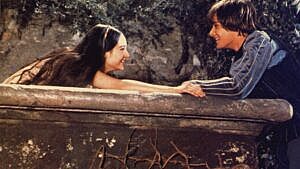Shakespeare’s works came to be depicted in Tamil cinema in three ways — through full adaptation of a story, through the borrowing of famous scenes, and by featuring a very shortened form of one of his plays in a film. A play within a film was a ruse often adopted to pad up entertainment and create opportunities for long, flowery dialogue.
Romeo and Juliet
Romeo and Juliet is a play, where a feud between two powerful families erupts into bloodshed. A group of masked Montagues (Romeo’s family name) risk further conflict by gatecrashing a Capulet (Juliet’s family name) party. A young lovesick Romeo Montague falls instantly in love with Juliet Capulet. After the party, Romeo sneaks to Juliet’s balcony. He finds Juliet sighs and speaks her feelings of love out loud.
Romeo admits his love to her and Juliet vice versa. On the other hand, her father wants her to marry a man of his choice, the County Paris. With the help of Juliet’s nurse secretly plans for Juliet and Romeo’s marriage. The plan becomes an utter failure. Soon, Juliet follows the Friar’s plot and fakes her death. The message fails to reach Romeo, and believing Juliet dead, he takes his life in her tomb. Juliet wakes to find Romeo’s corpse beside her and kills herself. The grieving family agrees to end their feud.
Ambikapathy
The Bard’s first peep into Tamil screen was through Ambikapathy (1937) directed by the legendary Ellis R. Dungan. Liberally borrowing from Shakespeare, Dungan organized the nocturnal rendezvous between lovelorn Ambikapathy and the princess along with the pattern of the balcony scene in Romeo and Juliet. The sequence in which the friend of the princess brings a message from Ambikapathy was also lifted from Romeo and Juliet.
The film featured the Romeo-Juliet type romance between Bhagavathar and Santhanalakshmi. Dungan, who did not know Tamil, used Shakespeare’s Romeo and Juliet as an inspiration and incorporated some of its scenes in the script. The writer for the film was the Tamil scholar,
Thanigachalam working under the pen name Elangovan. He translated the scenes Dungan had marked out from Shakespeare into Tamil. One of them was the balcony scene. The lines describing Romeo taking leave of Juliet – “Sleep dwell upon thine eyes, peace in thy breast”, were translated by Elangovan as “Thookkam Un Kangalai Thazhuvattum! Amaithi Un Nenjil Nilavattum.” Dungan also introduced some daring (for that period) intimate scenes like Ambikapathi carrying Amaravathi to the bed and Ambikapathi winking at her.
Parutheveerean
Parutheveerean is a spin on the Romeo-Juliet template, where warring families oppose the young lovers getting together. Veeran (Karthi) ‘s life is spent in and out of the local jail. He is almost always for crimes involving the aruvaa. His big dream is to land up in a big Chennai prison. Muthazhagu (Priyamani) adores him and has been in love with him since she was 8 when he rescued her from drowning in a well. Sevvazhai (Saravanan) is Paruthiveeran’s uncle, who raised him after the death of his parents. Kazhuva Thevar (Ponvannan) places family and caste honour before his daughter Muthazhagu’s wishes.
We know that a Shakespearean tragedy awaits us. Thevar will not allow his daughter to wed Paruthiveeran, which would shame the family and clan. And he is prepared to sacrifice lives for this. Inspired by Romeo and Juliet, with feuding families and bitter enmity, “Paruthiveeran” relies a little too heavily on specificity to push a universal subject. The incidents, customs and mannerisms used are highly region-specific.
There is another movie with a similar title, Romeo and Juliet. That movie is not related to the play. This movie stars Jayam Ravi and Hansika. Romeo and Juliet have been inspired or adopted by many directors and screenwriters. Love is universal, so this play is universal.
Subscribe to our email newsletter to get the latest posts delivered right to your email.





Comments